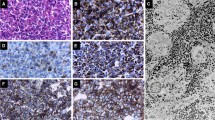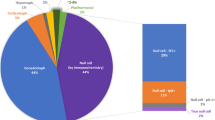Abstract
The purpose of the present study is to evaluate the prevalence of the gsp oncogene in Brazilian patients harboring somatotropinomas and non-functioning pituitary adenomas (NFPA). Patients and methods Deoxyribonucleic acid was extracted from 54 somatotropinomas and 14 NFPA. Exons 8 and 9 (including codons 201 and 227, respectively) of the GNAS gene were amplified by polymerase chain reaction (PCR). The PCR products were then purified and sequenced using the same primers. Results The gsp oncogene was found in nine tumors (eight somatotropinomas). The prevalence among somatotropinomas was 15% and among NFPA was 7%. The mutation was found in codon 201 in eight tumors and in codon 227 in one tumor (a somatotropinoma). No differences were found in age, sex, GH, and IGF-I levels or tumor volume at diagnosis between gsp+ and gsp− patients. Conclusion We found a lower than expected prevalence of gsp mutations in somatotropinomas and a similar prevalence in NFPA compared to previous studies from other countries.
Similar content being viewed by others
References
Spiegel AM (1996) Mutations in G proteins and G protein-coupled receptors in endocrine disease. J Clin Endocrinol Metab 81:2434–2442. doi:10.1210/jc.81.7.2434
Landis CA, Masters SB, Spada A et al (1989) GTPase inhibiting mutations activate the alpha chain of Gs and stimulate adenylyl cyclase in human pituitary tumors. Nature 340:692–696. doi:10.1038/340692a0
Williamson EA, Ince PG, Harrison D et al (1995) G-protein mutations in human pituitary adrenocorticotrophic hormone-secreting adenomas. Eur J Clin Invest 25:128–131. doi:10.1111/j.1365-2362.1995.tb01537.x
Riminucci M, Collins MT, Lala R et al (2002) An R201H activating mutation of the GNAS1 (Gsalpha) gene in a corticotroph pituitary adenoma. Mol Pathol 55:58–60. doi:10.1136/mp. 55.1.58
Tordjman K, Stern N, Ouaknine G et al (1993) Activating mutations of the Gs alpha-gene in nonfunctioning pituitary tumors. J Clin Endocrinol Metab 77:765–769. doi:10.1210/jc.77.3.765
Williamson EA, Daniels M, Foster S et al (1994) Gs alpha and Gi2 alpha mutations in clinically non-functioning pituitary tumors. Clin Endocrinol (Oxf) 41:815–820. doi:10.1111/j.1365-2265.1994.tb02798.x
Landis CA, Harsh G, Lyons J et al (1990) Clinical characteristics of acromegalic patients whose pituitary tumors contain mutant Gs protein. J Clin Endocrinol Metab 71:1416–1420
Drews RT, Gravel RA, Collu R (1992) Identification of G protein alpha subunit mutations in human growth hormone (GH)- and GH/prolactin-secreting pituitary tumors by single-strand conformation polymorphism (SSCP) analysis. Mol Cell Endocrinol 87:125–129. doi:10.1016/0303-7207(92)90240-7
Yoshimoto K, Iwahana H, Fukuda A et al (1993) Rare mutations of the Gs alpha subunit gene in human endocrine tumors. Mutation detection by polymerase chain reaction-primer-introduced restriction analysis. Cancer 72:1386–1393. doi :10.1002/1097-0142(19930815)72:4<1386::AID-CNCR2820720439>3.0.CO;2-J
Hosoi E, Yokogoshi Y, Hosoi E et al (1993) Analysis of the Gs alpha gene in growth hormone-secreting pituitary adenomas by the polymerase chain reaction-direct sequencing method using paraffin-embedded tissues. Acta Endocrinol (Copenh) 129:301–306
Adams EF, Brockmeier S, Friedmann E et al (1993) Clinical and biochemical characteristics of acromegalic patients harboring gsp-positive and gsp-negative pituitary tumors. Neurosurgery 33:198–203. doi:10.1097/00006123-199308000-00003
Yang I, Park S, Ryu M et al (1996) Characteristics of gsp-positive growth hormone-secreting pituitary tumors in Korean acromegalic patients. Eur J Endocrinol 134:720–726
Shi Y, Tang D, Deng J et al (1998) Detection of gsp oncogene in growth hormone-secreting pituitary adenomas and the study of clinical characteristics of acromegalic patients with gsp-positive pituitary tumors. Chin Med J 111:891–894
Ballaré E, Mantovani S, Lania A et al (1998) Activating mutations of the Gs alpha gene are associated with low levels of Gs alpha protein in growth hormone-secreting tumors. J Clin Endocrinol Metab 83:4386–4390. doi:10.1210/jc.83.12.4386
Barlier A, Gunz G, Zamora AJ et al (1998) Prognostic and therapeutic consequences of Gs alpha mutations in somatotroph adenomas. J Clin Endocrinol Metab 83:1604–1610. doi:10.1210/jc.83.5.1604
Buchfelder M, Fahlbusch R, Merz T et al (1999) Clinical correlates in acromegalic patients with pituitary tumors expressing GSP oncogenes. Pituitary 1:181–185. doi:10.1023/A:1009905131334
Johnson MC, Codner E, Eggers M et al (1999) Gps mutations in Chilean patients harboring growth hormone-secreting pituitary tumors. J Pediatr Endocrinol Metab 12:381–387
Kim HJ, Kim MS, Park YJ et al (2001) Prevalence of Gs alpha mutations in Korean patients with pituitary adenomas. J Endocrinol 168:221–226. doi:10.1677/joe.0.1680221
Corbetta S, Ballaré E, Mantovani G et al (2001) Somatostatin receptor subtype 2 and 5 in human GH-secreting pituitary adenomas: analysis of gene sequence and mRNA expression. Eur J Clin Invest 31:208–214. doi:10.1046/j.1365-2362.2001.00786.x
Kan B, Esapa C, Sipahi T et al (2003) G protein mutations in pituitary tumors: a study on Turkish patients. Pituitary 6:75–80. doi:10.1023/B:PITU.0000004797.89592.5e
Park C, Yang I, Woo J et al (2004) Somatostatin (SRIF) receptor subtype 2 and 5 gene expression in growth hormone-secreting pituitary adenomas: the relationship with endogenous SRIF activity and response to octreotide. Endocr J 51:227–236. doi:10.1507/endocrj.51.227
Mendoza V, Sosa E, Espinosa-de-Los-Monteros AL et al (2005) GSPalpha mutations in Mexican patients with acromegaly: potential impact on long term prognosis. Growth Horm IGF Res 15:28–32. doi:10.1016/j.ghir.2004.10.001
Yasufuku-Takano J, Takano K, Morita K et al (2006) Does the prevalence of gsp mutations in GH-secreting pituitary adenomas differ geographically or racially? Prevalence of gsp mutations in Japanese patients revisited. Clin Endocrinol (Oxf) 64:91–96. doi:10.1111/j.1365-2265.2005.02423.x
Metzler M, Luedecke DK, Saeger W et al (2006) Low prevalence of Gs alpha mutations in śomatotroph adenomas of children and adolescents. Cancer Genet Cytogenet 166:146–151. doi:10.1016/j.cancergencyto.2005.11.001
Freda PU, Chung WK, Matsuoka N et al (2007) Analysis of GNAS mutations in 60 growth hormone secreting pituitary tumors: correlation with clinical and pathological characteristics and surgical outcome based on highly sensitive GH and IGF-I criteria for remission. Pituitary 10:275–282. doi:10.1007/s11102-007-0058-2
Spada A, Arosio M, Bochicchio D et al (1990) Clinical, biochemical, and morphological correlates in patients bearing growth hormone-secreting pituitary tumors with or without constitutively active adenylyl cyclase. J Clin Endocrinol Metab 71:1421–1426
Jallad RS, Musolino NR, Salgado LR et al (2005) Treatment of acromegaly with octreotide-LAR: extensive experience in a Brazilian institution. Clin Endocrinol (Oxf) 63:168–175. doi:10.1111/j.1365-2265.2005.02317.x
Freda PU, Katznelson L, van der Lely AJ et al (2005) Long-acting somatostatin analog therapy of acromegaly: a meta-analysis. J Clin Endocrinol Metab 90:4465–4473. doi:10.1210/jc.2005-0260
Holdaway IM, Rajasoorya RC, Gamble GD (2004) Factors influencing mortality in acromegaly. J Clin Endocrinol Metab 89:667–674. doi:10.1210/jc.2003-031199
Ayuk J, Clayton RN, Holder G et al (2004) Growth hormone and pituitary radiotherapy, but not serum insulin-like growth factor-I concentrations, predict excess mortality in patients with acromegaly. J Clin Endocrinol Metab 89:1613–1617. doi:10.1210/jc.2003-031584
Author information
Authors and Affiliations
Corresponding author
Rights and permissions
About this article
Cite this article
Taboada, G.F., Tabet, A.L.O., Naves, L.A. et al. Prevalence of gsp oncogene in somatotropinomas and clinically non-functioning pituitary adenomas: our experience. Pituitary 12, 165–169 (2009). https://doi.org/10.1007/s11102-008-0136-0
Published:
Issue Date:
DOI: https://doi.org/10.1007/s11102-008-0136-0




